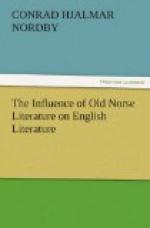Thomas Carlyle, seeking to explain the worship of a pagan divinity, chose Odin as the noblest example of such a hero. The picture of Odin he drew from the prose Edda, mainly, and his purpose required that he paint the picture in the most attractive colors. So it happened that our English literature got its first complete view of Old Norse ethics and art. The memory of Gray’s “dreadful songs” had ruled for almost a century, and ordinary readers might be pardoned for thinking that Old Norse literature, like Old Norse history, was written in blood. We have seen that Gray’s imitators perpetuated the old idea, and that even Scott sanctioned it, and now we see England’s emancipation from it. The grouty old Scotchman of Craigenputtoch knew no more Icelandic than most of his fellow countrymen (be it noted that he said: “From the Humber upwards, all over Scotland, the speech of the common people is still in a singular degree Icelandic, its Germanism has still a peculiar Norse tinge"); but he saw far more deeply into the heart of Icelandic literature than anybody before him. His emphasis of its many sidedness, of its sincerity, its humanity, its simplicity, its directness, its humor and its wisdom, was the signal for a change in the popular estimation of its worth to our modern art. Since his day we have had Morris and Arnold and a host of minor singers, and the nineteenth century revival of interest in Old Norse literature.
The other work by Carlyle dealing directly with Old Norse material is The Early Kings of Norway. Here he digests Heimskringla, which was obtainable through Laing’s translation, in a way to stir the blood. The story, as he tells it, is breathlessly interesting, and it is a pity that readers of Carlyle so often stop short of this work. As in the Hero-Worship, he shows this Teutonic bias, and the religious training that minified Greek literature.




